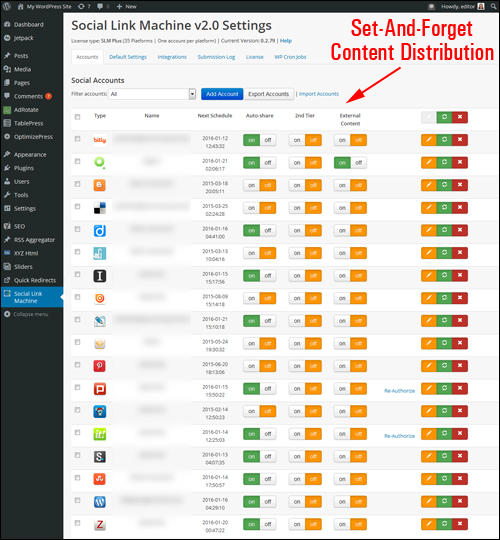 Welcome to Part Four of our Web Traffic Blueprint article series, where we show you how to create an automated traffic machine using the WordPress CMS.
Welcome to Part Four of our Web Traffic Blueprint article series, where we show you how to create an automated traffic machine using the WordPress CMS.
So far, here is what we have covered in this article series:
In Part One of this article series, we explained why using an expertly configured WordPress website is the key to automating traffic to your site …
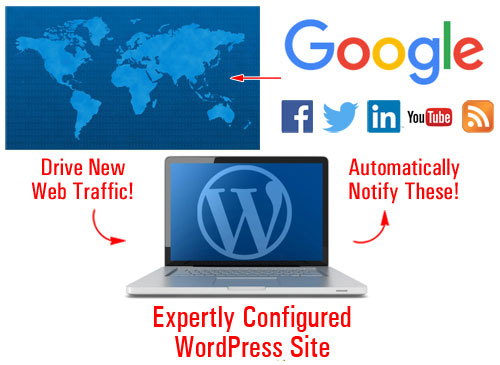
(With an expertly configured WordPress website, all you have to do to automatically bring more traffic is post web content consistently!)
In Part 2, we looked at the setup phase. We helped you understand the best way to get started if you don’t have a website yet, how to set things up if you already have a website, and what to do if your existing site has been built with WordPress.
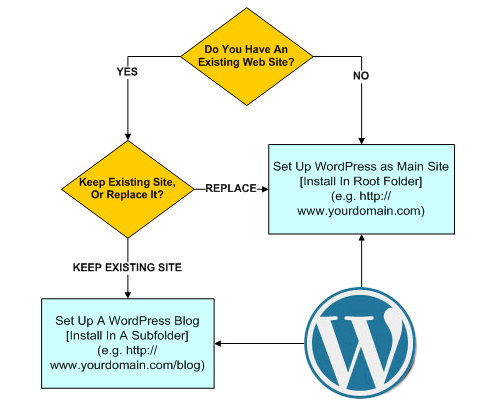
(In Part two we show you where to set up WordPress on your domain)
In Part Three, we discuss the configuration phase of this blueprint.
Here, we configure all the settings that can affect your website’s traffic-getting ability …
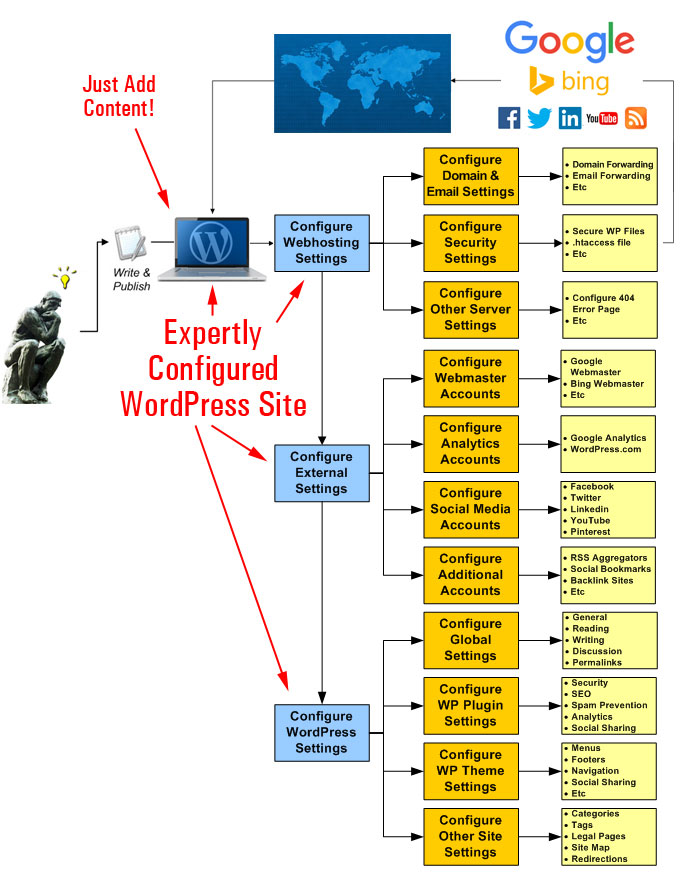
(In Part Three you will configure hosting settings, internal settings, and external settings that can affect your website’s ability to generate traffic automatically)
In Part Four, we will look at ways to automate your traffic using a number of WordPress plugins.
Why Automate The Traffic-Getting Process?
Depending on which marketing experts you listen to, you could end up trying to spend a couple of hours every day (or more) promoting your business on social media.
Most businesses lack the time, resources and financial means to employ the services of a full-time marketing and content creation department and engage in the kind of content marketing that many online marketing experts recommend. If you spent all of your time posting updates on Twitter, LinkedIn, and Facebook in addition to researching and writing content for your blog or website, how would anything in your business get done?
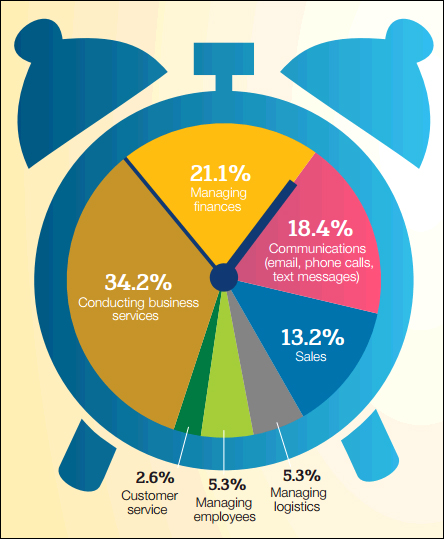
(Small businesses spend most of their working hours keeping their businesses up and running. Infographic source: National Federation Of Independent Businesses)
Small businesses spend most of their time trying to keep their businesses up and running. In addition to running a business, there’s sales and marketing. After all, businesses need to remain competitive and make sales in order to survive.
Marketing research done in 2012 by email and social media marketing company Vertical Response found that:
- 43% of all businesses surveyed spent 6 or more hours per week on social media (the rest spent even more time – between 6 and 21+ hours per week). This was a 66% increase from the previous year, so if the same research was done today, the figures would most likely be significantly higher.
- More than half of all small businesses surveyed spent 1-3 hours or more to create a blog post.
- Finding and posting content for social media consumed the most time online.
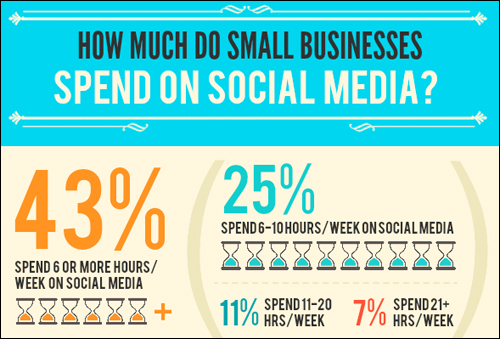
(Small businesses are spending more time each year marketing and promoting themselves online. Infographic source: VerticalResponse)
As small businesses spend more time on online marketing in order to compete and survive, this puts more and more pressure on businesses to focus their time on other important areas …

(Businesses with limited budgets, time, and resources and many areas to focus on need to plan their marketing strategy very carefully.)
Another important thing to keep in mind is that, in addition to spending time promoting and marketing your business on a number of social websites, you are investing all of your efforts into virtual real estate that you have no control over. You don’t own Twitter, Facebook, or LinkedIn. These sites often will make decisions that can dramatically affect your business without prior warning. Why invest so much time and effort building content on rented real estate? With a self-hosted WordPress website, you can control your own real estate and publish your content automatically to other online accounts.
Investing in automation to save time and increase productivity is not new. Businesses of all sizes have been doing it ever since the dawn of the Industrial Age. In the Digital Age, however, the increased availability of hundreds of new channels for promoting and marketing a business online creates a number of dilemmas for business owners and business managers, especially for those with limited time, resources, and marketing budgets. For example:
- Which marketing channels should you focus more of your time, budget, and your efforts on?
- Should you invest so much time and effort building a web presence on other people’s sites (e.g. Facebook, LinkedIn, Tumblr, etc.) while ignoring the benefits of building content on your own domain?
- Do you create new content for every channel you plan to include in your marketing strategy?
The Benefits Of Automating Your Traffic Generation With WordPress
What I’d like to share with you now, is a free, simple, and effective method for automating the traffic-getting process with WordPress.
With this method, you will be able to:
- Save time creating content for your website or blog and other marketing channels (e.g. social media),
- Save money on content creation and unnecessary web marketing channels,
- Determine which channels you should focus more efforts, time, and your budget on,
- Invest most of your time and efforts building your own asset instead of someone else’s and still benefit from other people’s marketing channels.
![]()
Many automated traffic solutions tend to focus on black hat methods, such as manipulating search engine results. This is not what the focus of this article series is about. In fact, we urge you to avoid using black hat websites, software, techniques, and anything that violates the policies and terms of service of companies like Facebook, Google, LinkedIn, etc..

(Automating your web traffic does not need to involve using black hat techniques!)
The purpose of this series of articles is to show you how to be smart with your resources and automate your content distribution in order to leverage your time and marketing efforts, and get additional exposure online from websites that your target audience frequents.
An Automated Content Distribution, Traffic And Lead Generation, And Sales & Marketing System
As we’ve just seen in the previous section, most business owners lack the time, human resources and financial means to engage in the kind of content marketing that most experts prescribe. What you want to do, then, is be strategic with your limited time, budget, and resources.
So, instead of posting content to services one at a time, which is very time-consuming …
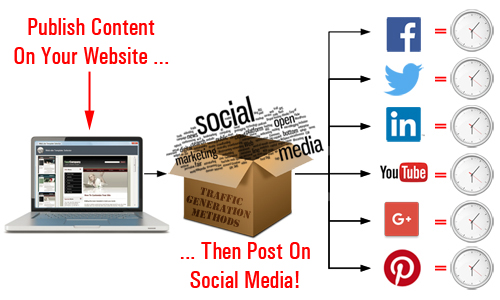
(Posting content to different services one by one can be extremely time-consuming!)
Why not choose a smarter, time-saving approach like this instead …
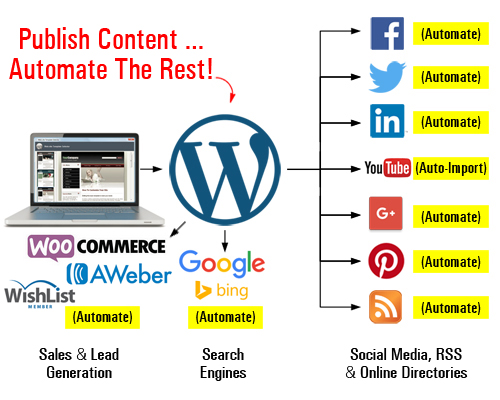
(Set up an automated content distribution, lead and traffic generation, and sales and marketing system with WordPress)
With an expertly configured WordPress site, you can build more than just a website for your business … you can set up an automated traffic and lead generation and sales & marketing system, where all you do is publish your content and WordPress then automates the rest.
With WordPress, you can publish content one-time, and automate the distribution of your content to all other services.
You can:
- Automatically distribute content to social channels and social bookmarking sites,
- Distribute content (and comments) automatically to other blogs and web properties using RSS
- Automatically import content (e.g. videos)
As your business evolves, you can add more functionality and automate processes like:
- Sell products and services with e-commerce,
- Capture leads with opt-in forms and add your subscribers to newsletters and autoresponders,
- Allow visitors to register on your site with different membership levels,
- And so much more!
You can do all of this using inexpensive WordPress plugins. Once these plugins are installed and configured on your site, just direct your visitors to the appropriate sections (e.g. your store, subscription forms, membership area, etc.)
How do you get all of this done?
Simple … first, set up your website or blog as described in Part 2. Then, get it all configured as shown in Part Three. After all this is in place, you can then connect all of the dots using plugins.
The video below shows you how everything works once your WordPress site has been expertly configured …
WordPress Web Traffic Blueprint – Traffic Plugins
Let’s take a quick look at a number of traffic-generating WordPress plugins that can be used to:
- Distribute content automatically to social media sites and social bookmarking websites
- Post comments automatically to other blogs
- Syndicate content automatically via RSS to other online properties
Jetpack WordPress Plugin
You can get your posts automatically distributed to sites like Twitter, Facebook, Tumblr, GooglePlus, LinkedIn and more as soon as you publish new content using a WordPress plugin like JetPack.
Download URL: https://jetpack.com/
Jetpack is a free WordPress plugin with many great features.
After installing Jetpack, connect the plugin to the WordPress.com account set up in Part Three …
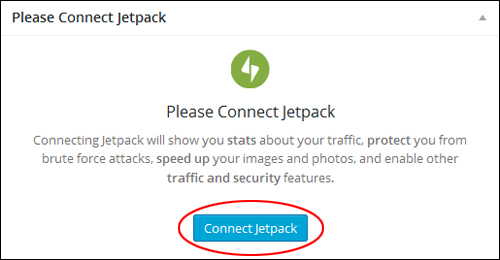
(Make sure that Jetpack is connected to your WordPress.com account)
Next, activate the Publicize feature …
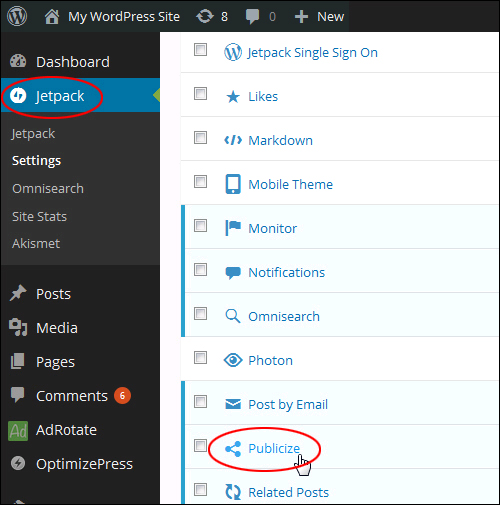
(Activate the Publicize feature)
Once this section is configured, you will be able to automatically share your posts on Facebook, Tumblr, Twitter, LinkedIn, Google+, and more …
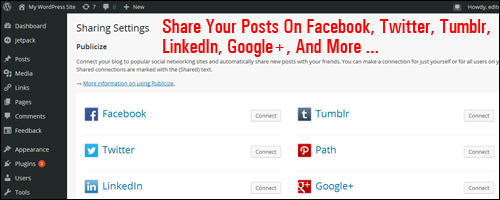
(Share your posts automatically on several social sites.)
After all plugin and account settings have been configured, your content is ready for distribution.
The Publicize feature adds a new section to your Publish box …
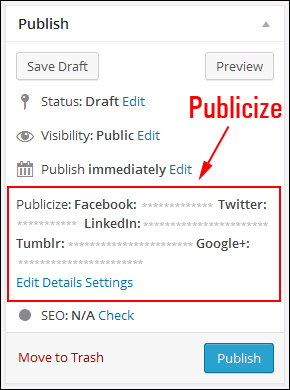
(Publicize details displayed in your publishing section.)
Now, whenever you publish a new post, it will automatically get shared on all of the accounts you have set up …

(As soon as new posts are published, they will be automatically distributed online.)
To learn more about this WordPress plugin, go here: Jetpack
CommentLuv
(CommentLuv)
WordPress has a built-in commenting function that allows your site users to interact with your website or blog, post comments, reply to existing comments and participate in discussions.
You can expand the WordPress native commenting feature using a number of 3rd-party plugins like Disqus, IntenseDebate, LiveFyre, or CommentLuv that integrate with social media, helping to share and spread your content online.
For example, with a plugin like CommentLuv (Pro version), you can create more user engagement on your site. The plugin encourages readers to comment using SEO and social reward features like social enticements for sharing content, SEO backlinks, the ability to add twitter names to comments, and using keywords in the name. This plugin will visit the site of the comment author while they are entering their comment and retrieve their latest blog posts, which can be included at the bottom of their comment when they click submit.
(CommentLuv Pro version can encourage a greater level of commenting and improve user engagement on your website or blog.)
To learn more about this powerful plugin, go here:
Social LinkMachine
(SocialLinkMachine – WordPress content distribution plugin)
Social LinkMachine is a set-and-forget plugin that lets you automatically syndicate content to many traffic-generating sites, build anchor text backlinks, include relevant videos and images, and social signals on auto-pilot …
(Social Link Machine – drip-feed your content automatically to dozens of traffic-generating platforms)
With Social LinkMachine installed, you can automatically drip-feed your content to dozens of authority platforms, including:
- Social Bookmarking Platforms: e.g. Deviantart, Linkagogo, Kippt, Reddit, etc.
- Blogs: e.g. Blog.com, Rebel Mouse, WordPress.com, etc.
- Social Platforms: Google Plus, Twitter, etc.
- Image Sharing: e.g. Pinterest, etc.
- PDF Sharing: e.g. Issuu, Scribd, etc.
Go here to learn more about this powerful plugin: Social Link Machine
Also, if you would like to know more about setting up social media monitoring (in order to get useful information about your content distribution campaigns), we have written a comprehensive article on social media monitoring tools and technologies that will help you identify new business opportunities, track competitor activity, see what online conversations are taking place that affect your business,etc. For more details, go here:
![]()
The above are just some examples of the many content distribution plugins that are available to WordPress users.
Kickstart Your WordPress Traffic System
After your traffic automation system has been set up, we recommend kickstarting the process of driving traffic to your site with the steps shown in this tutorial:
WordPress Traffic Automation Blueprint: Automated Content Distribution Phase – Summary
Once your WordPress site and plugins have been configured and set up, all you need to do then to start generating new web traffic is publish new content consistently.
![]()
We have created a complete email course designed to help you never run out of great content for your site:
Once you have configured your WordPress site, the next step is to optimize the process. This step is addressed in the next section of our WordPress Traffic System series.
This is the end of Section Four
To read more, click on the link below:

***
"Learning WordPress has been a huge stumbling block for me. I've been looking for something that covers absolutely everything but doesn't cost an arm and a leg. Thank you so much ... you have just provided me with what I have been looking for! Truly appreciated!" - Tanya
***





